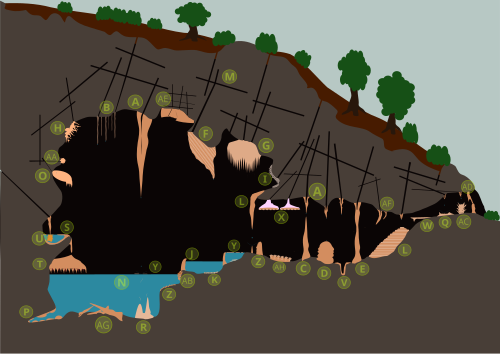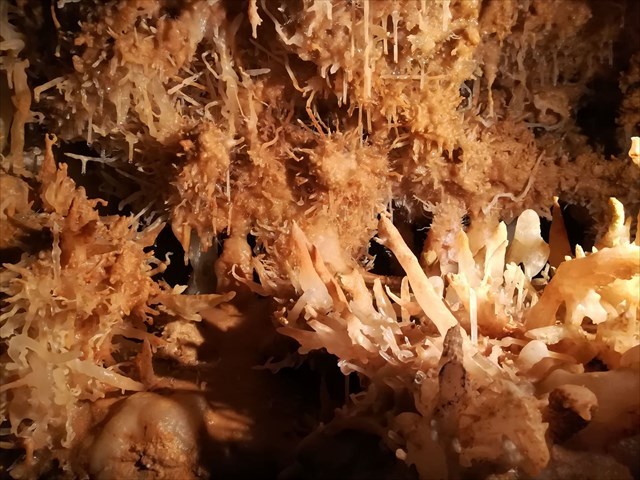[FR]
La grotte du Grand Roc
La découverte
C’est en 1924 que Jean Maury, spéléologue et préhistorien, découvre la caverne du Grand Roc. Alors qu’il fouillait depuis longtemps le gisement des « Marseilles » à Laugerie-Basse avec son ami Le Bel, il remarqua un porche dans la partie aérienne du Grand Roc.
Après bien des difficultés pour l’atteindre, il constata qu’un filet d’eau en sortait et envisagea tout de suite de possibles prolongements. Il se mit à l’ouvrage et perça un tunnel en plein roc sur une quarantaine de mètres de longueur. Peu à près le dernier tir de mine, il entreprit l’exploration en compagnie de sa fille et de sa sœur, il déboucha dans la petite grotte du Grand Roc.
De la découverte à l’exploitation touristique il n’y avait qu’un pas, il sera franchi en 1926.
Les Cristallisations du Grand Roc
Une véritable forêt minérale composée d'une incroyable variété et densité de cristallisations rarement égalées dans les autres grottes. Des coulées de calcite tapissent le sol par endroits.
Du plafond pendent des stalactites tantôt fines, tantôt imposantes et translucides. Du sol partent des stalagmites se rejoignant parfois pour créer des colonnes, parsemées par quantité de concrétions excentriques et de draperies.
Formations géologiques
Une stalagmite est un spéléothème, une concrétion qui se forme sur le sol des grottes et souterrains par la chute lente et continue d'eaux calcaires et par « l'effet splash » de celles-ci. Lorsque la stalagmite, en poursuivant sa lente croissance, rejoint la stalactite qui se forme au plafond de la grotte, les deux concrétions se soudent progressivement et forment ainsi un véritable pilier stalagmitique, ou colonne.

les différents types de spéléothèmes : *A — stalactite *B — fistuleuses *C — stalagmite *D — stalagmite en cône *E — colonne *F — draperie *G — méduse *H — hélictites *I — mondmilch *J — margelle de gour *K — cristaux de calcite *L — cascade de gours *M — karst *N — lac, gour *O — disque *P — cave cloud *Q — perles de caverne *R — tower cone *S — trottoir *T — baldacchino canopy *U — bottlebrush stalactite *V — antistalagmite *W — coulée stalagmitique (en) (le remplissage inférieur a été lavé) *X — trays *Y — calcite flottante *Z — coralloïdes *AA — frostwork *AB — coulée *AC — stalagmite en pile d'assiettes *AD — speleoseismite *AE — Filonnet de calcite en relief *AF — stalactite courbe *AG — stalactites brisées
voici quelques photos de spéléothèmes que l'on peut voir a l'intérieur de la grotte du grand roc:


l’accès à la grotte est payant mais inclus une visite guidée qui permet de découvrir la richesse et l'histoire de cette splendide grotte.
pour loguer cette earthcache vous devez répondre correctement aux questions suivantes :
- quelles sont les spécificités géologiques des stalactites / stalagmites trouvées dans la grotte du grand roc ?
- quelle en est selon vous la raison ?
Vous pouvez si vous le souhaitez, ajouter une photo de la grotte ou de vous près de la grotte
Loguez cette cache "Found it" et envoyez-moi vos propositions de réponses soit via mon profil, soit via la messagerie geocaching.com (Message Center), et je vous contacterai en cas de problème.
source : wikipedia et informations locales
--- [EN]
The cave of the Great Rock
The Discovery
It was in 1924 that Jean Maury, speleologist and prehistorian, discovered the cave of the Grand Roc. While he and his friend Le Bel had been searching the Marseilles deposit in Laugerie-Basse for a long time, he noticed a porch in the aerial part of the Grand Roc.
After many difficulties to reach it, he noticed that a stream of water was coming out and immediately considered possible extensions. He set to work and built a rock tunnel about 40 metres long. About the last shot of mine, he undertook the exploration in company of his daughter and his sister, he emerged in the small cave of the Grand Roc.
From the discovery to the tourist exploitation there was only one step, it will be crossed in 1926.
The Crystallizations
A true mineral forest composed of an incredible variety and density of crystallizations rarely equalled in the other caves. Calcite flows cover the ground in places.
From the ceiling hang stalactites sometimes fine, sometimes imposing and translucent. From the ground stalagmites sometimes join to create columns, dotted with eccentric concretions and draperies.
Geological formations
A stalagmite is a speleothema, a concretion that forms on the ground of caves and subterranean caves by the slow and continuous fall of limestone water and by the "splash effect" of these. When the stalagmite, while continuing its slow growth, joins the stalactite which forms on the ceiling of the cave, the two concretions are gradually welded and thus form a true stalagmitic pillar, or column.

the different types of speleothems : *A Stalactite *B Soda straws *C Stalagmites *D Coned stalagmite *E Stalagnate or column *F Drapery *G Drapery *H Helictites *I Moonmilk *J Sinter pool, rimstone *K Calcite crystals *L Sinter terrace *M Karst *N Body of water *O Shield *P Cave clouds *Q Cave pearls *R Tower cones *S Shelfstones *T Baldacchino canopy *U Bottlebrush stalactite *V Conulite *W Flowstone *X Trays *Y Calcite rafts *Z Cave popcorn or coralloids *AA Frostworks *AB Flowstone *AC Splattermite *AD Speleoseismites *AE Boxworks *AF Oriented stalactite *AG collapsed rubble
here are some photos of speleothems that can be seen inside the cave of the great rock:


Access to the cave is charged but includes a guided tour that allows you to discover the richness and history of this splendid cave.
to log this earthcache you must correctly answer the following questions:
- what are the geological specificities of the stalactites / stalagmites found in the cave of the great rock?
- what do you think the reason is?
If you wish, you can add a picture of the cave or of yourself near the cave.
Log this cache "Found it" and send me your response proposals either via my profile or via geocaching.com (Message Center), and I will contact you in case of problems.
source : wikipedia & local informations